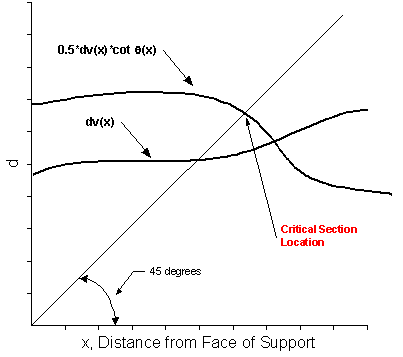|
PGSuper 7.0
Precast-prestressed Girder Bridges
|
|
PGSuper 7.0
Precast-prestressed Girder Bridges
|
The critical section for shear is located relative to, or at, the face of support. The face of support location is defined by the boundary conditions and connection geometry at an abutment or pier. Detailed information for face of support location is available in Face of Support.
This section provides a discussion of the requirements and assumptions for the algorithm to determine the critical section for shear location.
Article 5.7.3.2 (pre-2017: 5.8.3.2) states that the critical section for shear may be taken as dv from the face of support.
NOTE: Prior to LRFD 3rd Edition, 2004, the critical section was taken as the larger of dv or 0.5dvcot(q) from the face of support.
The LRFD Specification does not provide any guidance as to where dv and q are to be taken. Common practice is to take them at the location of the critical section. This makes the determination of the critical section for shear an iterative process since dv and q vary based on location and limit state.
The algorithm used to locate the critical section is as follows:
If X1 is equal to X, the critical section for shear is at X.
Prior to LRFD 3rd Edition, 2004, the critical section for shear is located as:
If X is not equal to the maximum of X1 and X2, go to Step 1 and repeat. Otherwise, X is the location of the critical section for shear.
Repeat for each limit state used for shear design.
A graphical solution would look as follows:

Although accurate and true to the Specifications, this method is impractical because of the large computational cost of calculating force envelopes at each guessed location in order to determine q(X) (a complete live load analysis would have to be run for every point). However, examination of many dv and q graphs reveals that their shape is well-behaved. Hence, it is practical to approximate the dv and q near the support. A piecewise linear interpolation is used. The control points used to create the curves will be at the 0.00, 0.05, and 0.10 points along the girder. It is believed that the critical section for shear should always fall within this range.